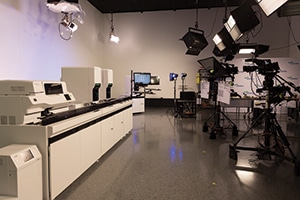
Inside Sysmex’s new Center for Learning, from which instructors broadcast live training classes on how to use the company’s diagnostic devices.
The new space has more than triple the training capacity of Sysmex’s previous Center for Learning. It has the capacity to train up to 4,400 people per year, including 3,000 customers, virtually and on site, and 1,400 Sysmex employees. The center houses seven broadcast studios for virtual instructor-led training.
DCISionRT study finds prognostic, predictive power
PreludeDx announced the results of a large cross-validation study of its DCISionRT test in patients with ductal carcinoma in situ that found DCISionRT to be a strong predictor of radiation benefit and able to identify patients with elevated recurrence risk who would be considered low risk by traditional clinical assessment.
The study report, titled “A biologic signature for breast ductal carcinoma in situ to predict radiation therapy (RT) benefit and assess recurrence risk,” is available online in Clinical Cancer Research (doi:10.1158/1078-0432.CCR-18-0842).
Lead investigator Fredrik Wärnberg, MD, PhD, associate professor of surgery at Uppsala University and a member of the Swedish Breast Cancer Group, said in a Prelude-issued statement: “The study analyzed the biology and clinical factors of 526 patients using DCISionRT and demonstrated that the biologic signature was excellent at identifying which patients would have a DCIS or invasive breast cancer recurrence within 10 years, but—importantly—also distinguished the patients most likely to have clinically meaningful radiation therapy benefit from those that would not.”
The DCISionRT Score identified patients with 10-year invasive breast cancer risks from three percent to 40 percent with surgery alone, or three percent to 10 percent with surgery and radiation therapy. The study also showed that DCISionRT distinguishes risk independent of clinicopathologic factors, according to Prelude, where the test found that 42 percent of clinicopathologically low-risk patients were in the DCISionRT elevated risk group and had a 10-year total recurrence risk of 31 percent.
In an oral presentation at the December 2017 San Antonio Breast Cancer Symposium, Dr. Wärnberg presented predictive data from the SweDCIS trial that demonstrated that the DCISionRT test was able to accurately stratify patients into a low-risk group with a non-significant risk reduction of one percent from radiation therapy and an elevated risk group that received a significant nine percent absolute benefit from radiation therapy.
Agena, PerkinElmer to collaborate
Agena Bioscience has entered into a collaboration with PerkinElmer in which the LabChip GX Touch nucleic acid analyzer for quality assessment and quantitation of DNA will be incorporated into the upfront workflow of Agena’s MassArray system. The companies have focused on targeting ctDNA in oncology liquid biopsy, where they say the combined systems support a single-day sample to results workflow for laboratories.
PerkinElmer’s LabChip GX Touch nucleic acid analyzer provides electrophoretic visual quality assessment and quantitation down to 25 pg/μL for DNA with flexible sample throughput options including 96-well and 384-well. According to Agena, this provides a streamlined upfront process to its 96- and 384-chip systems and the UltraSeek chemistry for liquid biopsy.
Agena says that, in evaluations performed by its team, the LabChip system ensured that sufficient DNA was present in the sample to achieve the sensitivity capabilities of the UltraSeek chemistry while efficiently identifying samples compromised by preanalytical variables that could result in false-negative results.
 CAP TODAY Pathology/Laboratory Medicine/Laboratory Management
CAP TODAY Pathology/Laboratory Medicine/Laboratory Management
